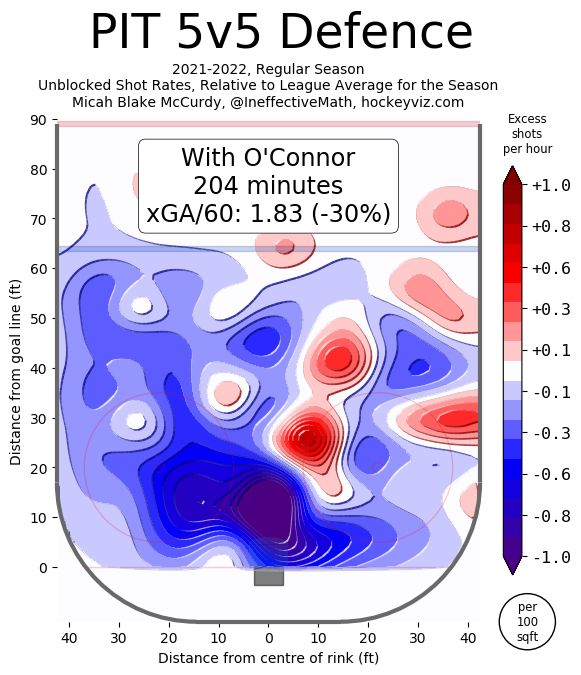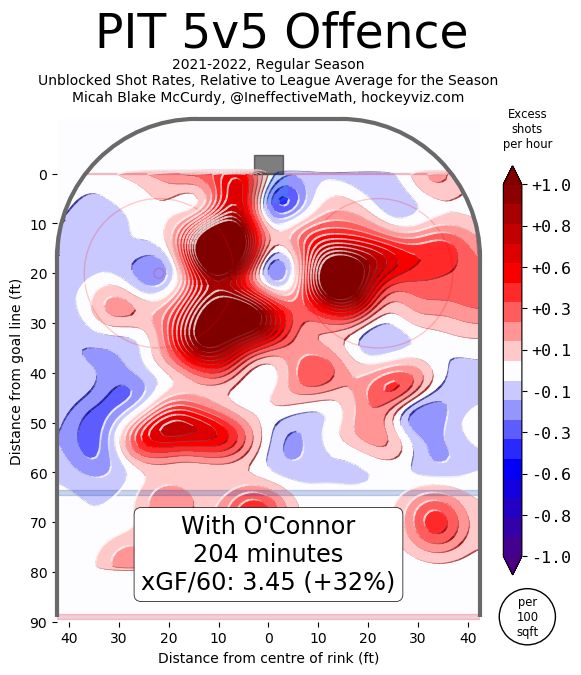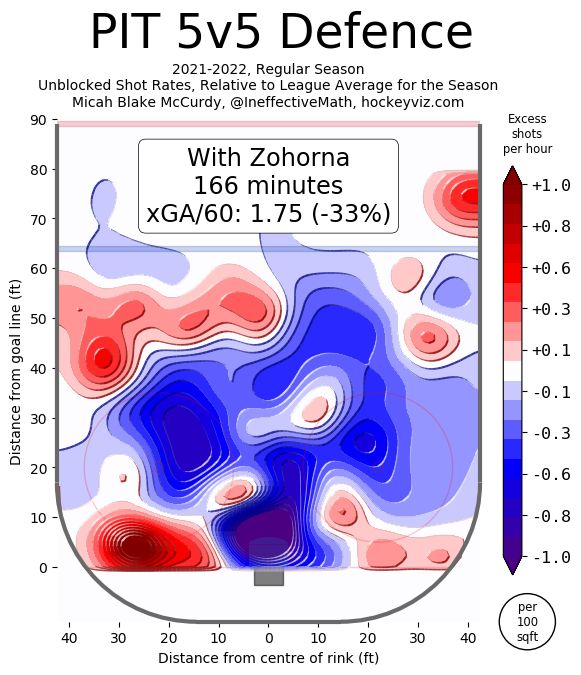After the Penguins dish out contracts to a top-pairing defenseman, second-line center and winger who can play in the top-six, much, if not all, of their current $23,208,158 in cap space will be gone. It will force them into rostering multiple skaters on close-to-NHL-minimum contracts.
Drew O'Connor and Radim Zohorna, who both count $750,000 against the salary cap next season at the NHL level, are two of just nine forwards currently under contract. They figure to graduate to lineup-regulars by the start of next season. It might seem as if that's the case out of nothing more than necessity, but rest assured, both skaters have the capability to provide positive impacts.
O'Connor, 24, played 10 games for the Penguins in the 2020-21 season, recording a lone assist and firing just eight shots on goal. At the time, he appeared to be nothing more than another tweener who could play in the NHL if a team needed a warm body, but would spend most of his time in the minors. Outside of those 10 games, O'Connor scored seven goals and totaled 19 points in 20 games with the Wilkes-Barre/Scranton Penguins in the AHL.
Fast-forward to this past season: O'Connor was thrust into the Penguins' opening-night lineup due to injuries. He recorded three goals and five points in his first four games before failing to get back on the scoresheet in his next 18 games. Shortly after, he suffered a collapsed lung and didn't make it back to the NHL until he suited up for two of the Penguins' first-round playoff games against the Rangers. In 33 minor-league games after recovering from the collapsed lung, he scored 12 goals and had 32 points.
Although the points dried up for O'Connor in the NHL after his blazing start, he continued to play a sturdy two-way game. In 203 minutes with him on the ice at five-on-five, the Penguins took 60.8% of the shot attempts and controlled a commanding 64.6% of the expected goals, per Evolving Hockey. Both marks were the best of any Penguins skater to play at least 200 minutes at five-on-five.
During that time, the Penguins were outscored 9-8, a pretty large discrepancy from what was expected based on the quality of chances he was on the ice for offensively and defensively. Part of that discrepancy can be explained by the .892 save percentage Penguins goaltenders posted when O'Connor was on the ice. Opponents mustered 1.69 expected goals against the Penguins per hour with him out there, but found the back of the net 2.67 times per hour.
Courtesy of HockeyViz, we can see where and how frequently opponents were taking shots with O'Connor on the ice (red indicates more shots relative to league-average, blue indicates fewer shots relative to league-average):

HockeyViz
While HockeyViz's expected goals model wasn't quite as high on the Penguins' defense during O'Connor's ice time (1.83 expected goals against per hour), the fact remains their opponents really struggled to get to the slot and net-front area. Of course, O'Connor received extremely sheltered deployment and didn't play against very tough competition, but raw results like that aren't anything to gloss over regardless of the context.
He didn't get to those results in traditional Patrice Bergeron-esque fashion. He's not elite in coverage or any sort of wizard with his stick. Those results came from a willingness to skate hard and take care of the puck. A 50/50 puck along the wall in the defensive zone? He's going all-out to win the race and improve the condition of the puck. It spoke volumes that a player that was out there trying to prove himself focused on doing the little things right instead of sacrificing certain aspects of the game for offense.
And that's the thing: He wasn't sacrificing offense by doing so. In fact, his willingness to do the tough things at the other end of the ice ultimately helped the Penguins' attack:

HockeyViz
For a bottom-six that, at least right now, includes only Jeff Carter, Brock McGinn and Teddy Blueger in addition to O'Connor and Zohorna, a player who can be a driver of quality chances is essential.
O'Connor drives a fair bit of that offense by shooting the puck himself (16.4 shot attempts per hour), and while most of his shots come from in tight, he also possesses a sneaky, crisp shot from distance:
He has the potential to be an above-average finisher, but his greatest strength -- which was a weakness just a year prior -- is his straight-ahead skating. Last offseason, he added strength to his lower-body. His stronger, more forceful stride gave him a boost in speed along with being harder to knock off the puck. That said, O'Connor is not very shifty and can struggle to keep the puck flat on the ice when forced to move left or right.
If he continues to use his straight-ahead skating to drive the center-lane in transition, the Penguins will benefit from it, just like they did here:
I don't see O'Connor developing into much of a playmaker. His hands are a bit limited, but by playing the game the right way and with attention to detail, some passing options will open up that don't require a ton of skill to execute:
Zohorna, 26, is less of a sure thing than O'Connor, but has more overall upside if he can capture it all and put it together.
He split 2020-21 between the NHL and AHL, playing eight and 12 games in each league, respectively. In the NHL, Zohorna scored twice and added a pair of assists for four points. In the AHL, he scored three goals and had 11 points.
This past season, the signing of Brian Boyle and an illness kept Zohorna at only 17 games with the Penguins. He scored twice and had six total points. That production isn't all that noteworthy, but like O'Connor, the Penguins controlled play in a massive way with him on the ice at five-on-five. In 166 minutes with Zohorna, the Penguins took 58.4% of the shot attempts and generated 62.3% of the expected goals. They outscored opponents, 13-1, in that time. No, that's not a typo. The Penguins surrendered one goal with him on the ice at five-on-five. In fact, Zohorna has been on the ice for only three goals against at five-on-five for the entirety of his limited career.
Just as O'Connor wasn't entirely responsible for the poor goaltending he received, Zohorna isn't entirely responsible for the strong goaltending he received, but even taking goaltending out of the equation and solely looking at the quality of chances against paints a nice picture of Zohorna's defensive impact:

HockeyViz
Contrary to public perception, Zohorna is a physical player. It's a component that helps generate the defensive results we just discussed. The physicality doesn't necessarily come in the form of bone-crunching hits, but it's still effective. The rate at which he threw hits (7.86 hits per hour) was second-highest on the Penguins.
He's got such a large frame that any sort of contact is likely to knock the opposition off balance, and when you combine that with his active stick and long reach, it's no mystery as to how the Penguins can keep the puck away from their own net when he's on the ice:
You'll see that exact sequence unfold in the neutral zone, as well, allowing the Penguins to negate any sort of zone time for the opposition before they even get to the zone.
The Penguins' offense with Zohorna this past season didn't generate a ton of quality looks (2.35 expected goals for per hour), but they still managed to find the back of the net 4.76 times per hour. The ridiculous 14.7% on-ice shooting percentage won't carry over into next season. They could counteract the regression, though, by getting Zohorna to shoot the puck more. He attempted just 8.2 shots per hour, and only 3.08 were on goal per hour.
Zohorna possesses a lethal shot, but his size makes it hard to find enough room to shoot. It won't last, but there's a reason he's converting on 23.5% of his career shots on goal thus far:
I'm of the belief that Zohorna has more upside than O'Connor at this point because he seems to process the game -- at least offensively -- better than O'Connor. While O'Connor is more of a straight-ahead player, Zohorna is a phenomenal skater for his size and is frequently changing lanes and angles, especially on the rush. He's also displayed an underrated passing ability in his limited time with the Penguins.
It doesn't mean he is or will be the better overall player, just that he could be if the stars align:
There are some concerns about Zohorna keeping up with the pace the Penguins like to play at. He averaged a little more than 10 minutes per game this past season and that figures to increase by at least several minutes next season. I didn't find his pace or speed to be a problem -- mainly due to his long stride making up for it -- but it is worth keeping in mind with the increased role.
O'Connor and Zohorna certainly aren't pushing the Penguins over the top toward contention. They aren't the same injection of youth that came with Bryan Rust and Jake Guentzel, and that's OK, the Penguins don't need them to be.
The Penguins need both of them to be above-average contributors on bargain-bin contracts. Both are more than capable.

